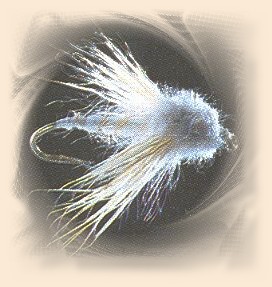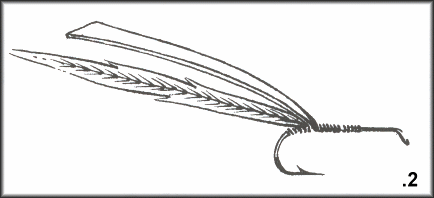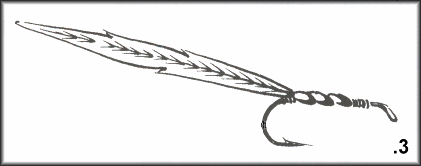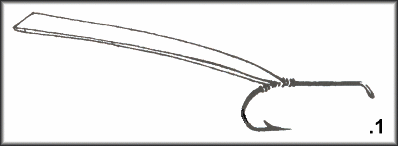|
3. Pull the foam down over the hook shank; bind it down by ribbing it with the
tying thread on the bobbin.

4. Palmer the cream hackle; clip the fibers short all the way around.
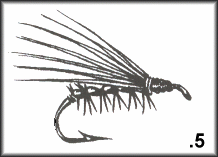
5. Tie in a heavy downwing of deer hair.

6. With a dubbing rope (created by twisting mink fur in a dubbing loop), figure-eight
the wings (leaving the hair split in a 45 degree backwards angle); wrap enough fur in
front of the wings to form a head.
7. Whip finish.
More:
It is not a large creek, maybe ten to twenty feet across on average, and brushy
enough to make casting in the dark difficult. The easiest way to fish it is to wade straight
upstream, avoiding the deeper outside corners. The best areas to fish are the boundaries
of a pool - the head, the tail, and both banks (anywhere except the deep center).
Alan caught trout on a Muddler, landing six of them in an hour, the best a 20-inch brown.
He missed too many fish at first on an erratic, strip retrieve. He started hooking more of
them on an across-stream cast and a simple, short-line swing, most of the strikes coming
as the fly straightened out and hung below him.
My choice for a pattern was the old reliable, the White Deer Hair Moth, not only because
it would catch trout but also because it would bring them to the surface hard. Up and across
stream cast, thrown with a curve, hooked the Moth in against the deep banks. With a dry
fly this slice of the stream was more productive than the tails of pools and runs (where Alan picked
up his fish on a Muddler.)
The best retrieve, at the end of the drift, was a quick upstream mend of the bellying line.
This maneuver not only threw new slack for another drift but make the fly dash upstream in
a smooth, one-to two-foot jot. The movement gave fish a new chance to notice the bulky
imitation silhouetted against the sky.
Browns and rainbows took the fly, crashing the surface loud enough for me to know when
to strike. The numbers of decent trout, all above 13 inches, in this stream was surprising
even to someone who had fished it a lot during the day. Four over 18 inches were landed.
Some fish, of course, hit the Moth with huge swirls but were never hooked, and these, always
the biggest in my mind, made the night special. ~ Gary LaFontaine
|

